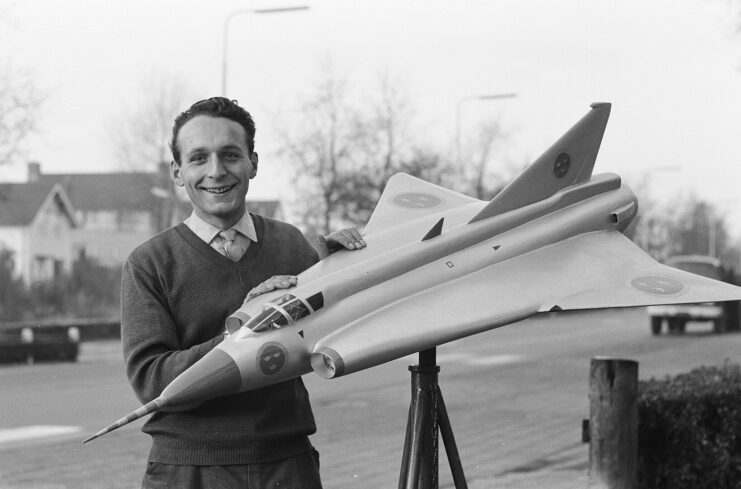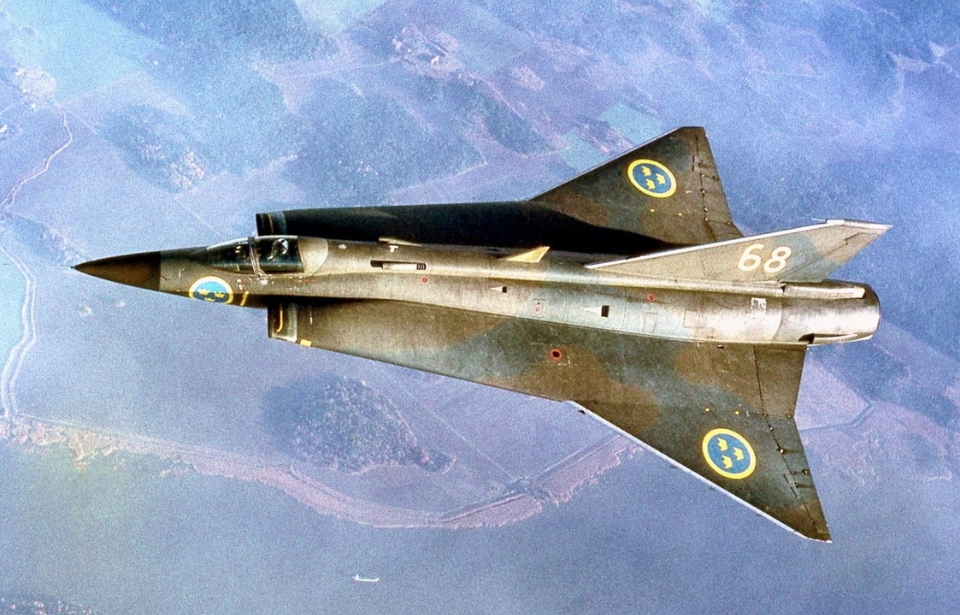Following World War II, there was a significant increase in the demand for advanced jet fighter technology. By the 1960s, Swedish engineers had devised the Saab J35 Draken, at first only as a theoretical design. The idea of a tail-less double-delta wing aircraft generated both excitement and caution, representing a bold leap into uncharted territory.
Despite the sheer scale of the task, Saab engineers approached the challenge with enthusiasm. Their steadfast dedication turned their work into a story that has become legendary.
Development of the Saab J35 Draken

The Swedish Air Force, determined not to fall behind in the development of advanced jet technology, set its sights on a supersonic fighter capable of intercepting bombers at high altitudes. A bold idea was developed, leading the Defence Materiel Administration to lay out a set of requirements for a cutting-edge interceptor.
Unlike its contemporary, the US Air Force’s Lockheed F-104 Starfighter, this Nordic creation had a distinctive role: operate from reinforced public roads, a strategic approach developed by the Swedish Ministry of Defence during the Cold War to guard against potential nuclear threats. Additionally, it needed to be capable of conducting operations in all weather conditions.
Enter the Saab J35 Draken – the “Nordic Dragon” – which embraced the challenge.
The J35, a testament to innovative design and engineering prowess, emerged from a daring decision to adopt the double-delta wing configuration. Despite being untested and potentially fraught with challenges, it provided a solution to many critical issues. The delta wing, with its robust structure and ample internal volume for fuel storage, held promise, albeit with a susceptibility to drag.
In the absence of modern aids like computer-aided testing and flight simulation, Swedish engineers began a slow and meticulous journey. After extensive wind tunnel testing and test flights, they crafted a small but airworthy prototype, the Saab 210 – or “Little Dragon.” Taking its first flight over Stockholm in January 1952, the Little Dragon breathed life into the J35 Draken.
Saab J35 Draken specs

The J35 Draken’s design was truly forward-thinking, featuring a distinctive double-delta wing configuration that was revolutionary at the time. This innovative design, marked by sharp angles, was key in balancing high-speed capabilities with low-speed stability.
The J35’s aerodynamics were further enhanced by its turbojet engine with afterburner capability, enabling the aircraft to reach impressive speeds and making it one of the first Western European-built jets to surpass Mach 2.
The aircraft’s body was expertly constructed, featuring a spacious cockpit that provided the pilot with a wide field of view. Equipped with advanced radar and fire-control systems, the J35 led in technological innovation. Its fuselage, split into front and rear sections, contained various vital systems and was securely fastened together.
For combat, the J35 carried its primary armament externally, including up to four AIM-9 Sidewinder short-range air-to-air missiles. Internally, it could carry an assortment of rockets and bombs, with the possibility of adding either two 30 mm cannons or extra external fuel tanks.
A rather bouncy start

The introduction of the Saab J35 Draken faced challenges from the start.
With its cutting-edge double-delta wing design, mastering it proved a difficult adjustment. Its natural instability added difficulty to landing, requiring precise manual stabilization from pilots. However, challenges often lead to breakthroughs. In this case, overcoming the difficulties revealed a new maneuver undiscovered by any other nation at the time.
Cobra Maneuver

In their quest to master the unpredictable nature of flight, Swedish test pilots discovered a valuable technique: the Cobra Maneuver. When encountering a high alpha stall with the J35 Draken, they realized they could regain control by swiftly adjusting the angle of attack to counter the stall.
Voila! This insight effectively transformed the J35 into its own airbrake, quickly reducing its speed.
Saab J35 Draken’s legacy

Not only was the J35 Draken a high-altitude interceptor, it also proved to be a capable dogfighter. With impressive quick-turn capability and its high speed, the Swedish fighter was twice as capable as other single-engine jets of the same era. The improved J35B model featured an enhanced power plant, an enlarged afterburner, a redesigned rear fuselage and integrated with the air defense control network, STRIL 60.
More from us: Sukhoi Su-35: The Russian Multirole Fighter That Screams Aerial Dominance
While the Cobra Maneuver is now associated with more modern aircraft like the Sukhoi Su-27 and the Mikoyan MiG-29, it’s important to remember where it all began. The J35 Draken took the aviation world by storm and will be remembered as the aircraft that accidentally discovered the maneuver.
